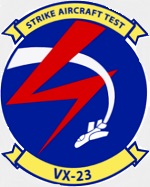Hobby Master HA6209 US Navy Lockheed-Martin F-35C Lightning II Joint Strike Fighter - CF-03, VX-23 "Salty Dogs", Naval Air Station Patuxent River, Maryland, 2016 [Low-Vis Scheme] (1:72 Scale)
"The F-35 program executive officer, has stated that the 'F-35 enjoys a significant Combat Loss Exchange Ratio advantage over the current and future air-to-air threats, to include Sukhois, which are currently being flown by the Russian, Indian, and Chinese Air Forces.'"
- Maj Gen Charles R. Davis, USAF, the F-35 program executive officer
 The Lockheed Martin F-35 Lightning II is a fifth-generation, single-seat, single-engine, stealth-capable military strike fighter, a multirole aircraft that can perform close air support, tactical bombing, and air superiority fighter missions. The F-35 has three different models; one is the conventional takeoff and landing variant, the second is short takeoff and vertical-landing variant, and the third is a carrier-based variant.
The Lockheed Martin F-35 Lightning II is a fifth-generation, single-seat, single-engine, stealth-capable military strike fighter, a multirole aircraft that can perform close air support, tactical bombing, and air superiority fighter missions. The F-35 has three different models; one is the conventional takeoff and landing variant, the second is short takeoff and vertical-landing variant, and the third is a carrier-based variant.
The F-35 is descended from the X-35, the product of the Joint Strike Fighter (JSF) program. Its development is being principally funded by the United States, with the United Kingdom, and other partner governments providing additional funding. It is being designed and built by an aerospace industry team led by Lockheed Martin with Northrop Grumman and BAE Systems as major partners. Demonstrator aircraft flew in 2000, with the first flight on December 15th, 2006.
The F-35C combines this unique capability of operating from a carrier deck with the unmatched 5th Generation capabilities of stealth, fused sensors and reliability, making the F-35C the Navy?s future first-day-of-the-war strike fighter.
The Navy and Marines require an aircraft capable of overcoming a variety of threats - surface-to-air missiles, air-to-air missiles and tactical aircraft. By leveraging this potent combination of stealth, advanced jamming and threat system destruction, the F-35C enhances survivability and increases mission success rates.
The F-35C variant has larger wings and more robust landing gear than the other variants, making it suitable for catapult launches and fly-in arrestments aboard naval aircraft carriers. Its wingtips also fold to allow for more room on the carrier?s deck while deployed.
The F-35C also has the greatest internal fuel capacity of the three F-35 variants. The F-35C carries nearly 20,000 pounds of internal fuel for longer range and better persistence than any other fighter in a combat configuration. And, like the F-35B, the F-35C uses probe and drogue refueling. This allows the Navy to operate its carriers a safe distance from the threat while its fighters reach remote targets.
Pictured here is a 1:72 scale replica of a US Navy Lockheed-Martin F-35C Lightning II Joint Strike Fighter that was assigned to VX-23 "Salty Dogs", then deployed to Naval Air Station Patuxent River, Maryland, during 2016.
Sold Out!
Dimensions:
Wingspan: 7-1/4-inches
Length: 8-1/2-inches
Release Date: December 2023
 Historical Account: "Patuxent" - Naval Air Station Patuxent River, also known as NAS Pax River, is a United States naval air station located in St. Mary's County, Maryland, on the Chesapeake Bay near the mouth of the Patuxent River.
Historical Account: "Patuxent" - Naval Air Station Patuxent River, also known as NAS Pax River, is a United States naval air station located in St. Mary's County, Maryland, on the Chesapeake Bay near the mouth of the Patuxent River.
It is home to Headquarters, Naval Air Systems Command (NAVAIR), the U.S. Naval Test Pilot School, the Atlantic Test Range, Patuxent River Naval Air Museum, and serves as a center for test and evaluation and systems acquisition relating to naval aviation. The station also operates a small outlying field, NOLF Webster.
Commissioned on April 1st, 1943, on land largely acquired through eminent domain, the air station grew rapidly in response to World War II and continued to evolve through the Cold War to the present.


